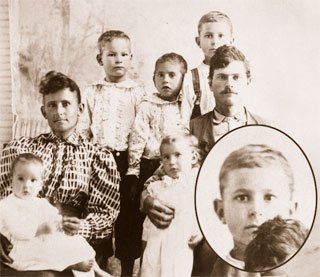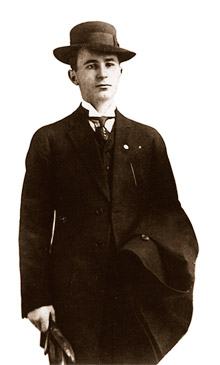Gilcrease Museum was founded in 1949 as a private museum by Tulsa oilman Thomas Gilcrease (1890-1962), who amassed the nation’s most comprehensive collection of art of the American West, as well as major collections of historical documents and artifacts. American art historian Richard Saunders once called Gilcrease Museum “a kind of Smithsonian Institution of the American West.” Although a powerful tribute, Saunders’s comment only hints at the museum’s ongoing impact and influence.

Born in Robiline, Louisiana, in 1890, Tom was the oldest of 14 children born to William and Elizabeth Gilcrease, a couple of Scots-Irish, French and Muscogee (Creek) Indian ancestry. Soon after his arrival the Gilcrease family moved to the Creek Nation in Oklahoma Territory where Tom enjoyed a rural childhood and developed an insatiable curiosity about the natural world around him. Raised on the gospel of work, as a boy he helped tend the Gilcrease family’s fields and store. Although his formal education was somewhat limited, a love of reading encouraged a lifelong love affair with history, especially that related to American Indians.
Thomas Gilcrease’s name was entered on the Creek tribal rolls when he was 9 years old. Tribal membership made Gilcrease eligible for a 160 acre allotment of land, fortuitously located within the famed Glenn Pool oilfield, scene of the first major discovery of petroleum in Oklahoma in 1905. By 1917 more than 30 wells dotted Gilcrease’s property, the income from which had enabled him to further his education at Bacone College in Muskogee, Oklahoma, and at an Emporia, Kansas, teacher’s college. Married to Belle Harlow in 1908 and the father of two sons, Tom Gilcrease found the lure of the oil patch irresistible and in 1922 founded his own exploration company.
Three years later the successful oilman embarked on a trip to Europe that would change his life forever. The journey exposed him to the wealth and grandeur of Old World culture, and it also whetted his appetite for collecting fine art. Knowing he could not compete with well-established collectors of European masters, Gilcrease embarked on a different, more personal course. He looked to his own heritage for inspiration and resolved to create a collection of fine objects that reflected the breadth of Native American history and culture.

In 1937 Gilcrease moved his company headquarters to San Antonio, Texas, to be closer to his major field operations. Thereafter he became more active as a collector and in 1942 formed the Thomas Gilcrease Foundation, in part to facilitate his ongoing collecting interests, but also to support such philanthropic efforts as Indian education. The following year he acted on a long held desire to establish a museum where he could exhibit his treasures for the public. Art historians generally consider this display, located at Gilcrease’s company headquarters in San Antonio, to be the first museum ever devoted to Western American art.
During the early 1930s, Gilcrease made steady, if not spectacular, additions to his collection, which eventually broadened to include books, manuscripts, and artifacts as well as art. Although his oil business had flourished in the previous decade, Gilcrease’s marriage to Belle Harlow had not, and in 1926 the couple divorced. Two years later, the entrepreneur married Norma Smallwood, a former Miss America. The second union produced a daughter, but within a few years this union also failed.
A string of remarkable acquisitions would vault Gilcrease to the forefront of Western Americana collectors by the end of the decade. The first of these, the purchase of Dr. Philip G. Cole’s incomparable western art collection in 1944, was also the most important. Widely regarded as the single greatest acquisition of western art of all time, the transaction netted the Oklahoman some 636 works of art as well as books, photographs, and associated archival material. The purchase included a number of Frederic Remington paintings and what has been called the finest collection of works by Charles M. Russell assembled during the artist’s lifetime.
After completing the Cole purchase, Gilcrease’s collecting quickened at a dizzying pace. In 1948 alone, the collector landed several major prizes, among them the estate of noted landscape painter Thomas Moran. The acquisition included some 2,000 works of art, including many exquisite watercolors of the Yellowstone region of Montana and Wyoming, and also archival material that helped reveal Moran’s creative process. That same year Gilcrease completed negotiations for the purchase of an important collection of art and correspondence of George Catlin, the first artist to travel extensively among tribal peoples of the American West. He also snapped up several romantic depictions of the American fur trade and Plains Indian life painted in the 1830s by Alfred Jacob Miller. To many knowledgeable observers the 1947 purchase of Thomas Eakins’s magnificent full-length portrait of famed ethnologist Frank Hamilton Cushing overshadowed them all.

It was during these years that Gilcrease purchased most of the works in the collection by Stone.
The acquisition of noteworthy paintings by such prominent American artists as Winslow Homer, John Singer Sargent, and James McNeill Whistler reflected his discriminating eye for quality and an impulse to collect distinguished works outside his declared areas of interest lent both breadth and content to the western American focus of his collection.
On periodic forays to the famous artists’ colony at Taos, New Mexico, Gilcrease developed friendships with and purchased paintings directly from several artists including Ernest Blumenschein and Bert Phillips. He acquired some 200 works from the prolific Joseph Henry Sharp alone, not to mention the fine collection of Indian artifacts the artist had gathered over the years for use as props in his work. Gilcrease also extended his encouragement and support to promising young Native American artists, collecting and commissioning work by Acee Blue Eagle, Woody Crumbo, and Willard Stone, among others.
Despite Gilcrease’s spectacular achievements as a collector in the 1940s, San Antonians never mustered much enthusiasm for his museum. Disappointed by their apathy, the founder closed the display in 1947, after only a few years of operation.
Undeterred by his failure in Texas, Gilcrease moved his collection back to Tulsa where he placed it in a new museum adjacent to his own modest sandstone home west of downtown. The founder opened the new facility, called the Thomas Gilcrease Museum, in May 1949.
Besides securing stunning artworks, the Oklahoman bought thousands of rare books, manuscripts, and documents including rare volumes documenting the Age of Exploration and created an impressive collection of early atlases and maps. An interest in the Spanish and Mexican influence on American history led him to acquire more than 100,000 pages of Hispanic source material, some of it dating from the 16th century. This important cache of the written word included documents related to such famous explorers as Christopher Columbus, Hernan Cortez, and Hernando de Soto, but also to the Spanish Inquisition in the Americas.
Among Gilcrease’s great prizes was the contents of the “Freedom Train,” which in the late 1940s and early 1950s toured the United States with a display of rare documents, including a certified copy of the Declaration of Independence and the Articles of Confederation once owned by Frederick the Great and a letter written by Thomas Jefferson on July 2, 1776.
Although he continued to collect at a torrid pace, the oil revenues that Gilcrease depended upon to finance his acquisitions began to lag and by 1953 the overextended collector found himself financially strapped and unable to pay some $2.5 million he owed to business associates and to galleries and art brokers for various acquisitions.

As he began to look for a way out of his difficulties, several suitors for his collection emerged. To fend off the entrees of competitors and to keep the collection intact, the City of Tulsa organized a successful bond issue in 1954, designed to pay the oilman’s debts and to secure his treasures for the community. Gilcrease transferred the title to his collection the following year, and the museum was renamed the Thomas Gilcrease Institute of American History and Art. In 1958 the founder deeded the museum buildings to the community along with more than 13 acres of land. Gilcrease committed the revenues from some of his oil properties toward the reimbursement of the original bond amount, which was achieved in 1985.
At the time the collection passed to the City of Tulsa, the Thomas Gilcrease Museum Association was formed by leading Tulsans who had promoted the publicly-funded acquisition.
Despite his financial travails, Gilcrease never lost his passion for collecting or for his collection. As his economic position improved in the late 1950s, he continued to acquire rare western Americana, although the field became increasingly crowded with eager collectors. An ongoing fascination with archaeology and ethnology also led him to sponsor several field excavations of Indian mounds in the Mississippi Valley. The objects acquired from his digs and his other post-1955 collecting efforts eventually reached the museum through a bequest after Gilcrease’s death from a heart attack in May 1962.
In 2008, the City of Tulsa and The University of Tulsa entered into a historic partnership to preserve and advance Gilcrease Museum. In its new role as steward of the museum and its collections, TU is leveraging its nationally recognized academic expertise in western American history, art history, anthropology, and archaeology to propel Gilcrease into a new era.
Although the indefatigable collector did not live to see the countless other gifts, donations, and improvements that enabled his museum to grow and flourish into the new millennium, by every measure Thomas Gilcrease realized his long held desire to leave a mark on the world. The museum that bears both his name and his spirit now, as during Gilcrease’s lifetime, houses the largest collection of Western American art ever assembled – and a fine art collection of more than 12,000 works. The Helmerich Center for American Research at Gilcrease Museum houses the vast archival collection acquired by Gilcrease, some 100,000 rare books, manuscripts and other archival material, much of it unique. Gilcrease Museum’s galleries and vaults display and store over a quarter million extraordinary artifacts related to the aboriginal people of the Americas.
Past Directors
Martin Wisendanger
Foundation Director, 1942 – 1947
Lester Hargrett
Foundation Director, July 1947 – September 1949
James T. Forest
Institute Director, July 1955 – January 1961
Glen Ames
Interim Institute Director, February 1961 – May 1961
Dean Krakel
Institute Director, June 1961 – November 1964
Paul Rossi
Deputy Director, November 1961 – December 1964
Interim Institute Director, October 1964 – December 1964
Institute Director, December 1964 – May 1972
Robert P. Hunter
Interim Institute Director, May 1972 – August 1972
William R. Best
Institute Director, September 1972 – January 1978
Fred A. Myers
Institute Director, July 1978 – October 1991
Gary F. Moore
Interim Institute Director, October 1991 – January 1992
Joan C. Troccoli
Institute Director, January 1992 – June 1995
Gary F. Moore
Interim Institute Director, July 1995 – June 1996
J. Brooks Joyner
Institute Director, July 1996 – May 2001
Hilary Kitz
Interim Institute Director, June 2001 – November 2002
Gary F. Moore
Interim Institute Director, November 2002 – August 2003
Joseph B. Schenk
Institute Director, December 2003 – December 2006
Gary F. Moore
Interim Institute Director, January 2007 – May 2008
Duane H. King
Vice President of Museum Affairs and Executive Director of Gilcrease Museum, May 2008 – May 2014
Susan Neal
Interim Director, June 2014 – March 2015
James Pepper Henry
Executive Director of Gilcrease Museum, March 2015 – April 2017
Susan Neal
Chief Operating Officer and Interim Director, April 2017 – August 2017
Executive Director of Gilcrease Museum, September 2017 – January 2024
Brian Lee Whisenhunt
Executive Director of Gilcrease Museum, Starting April 2024
